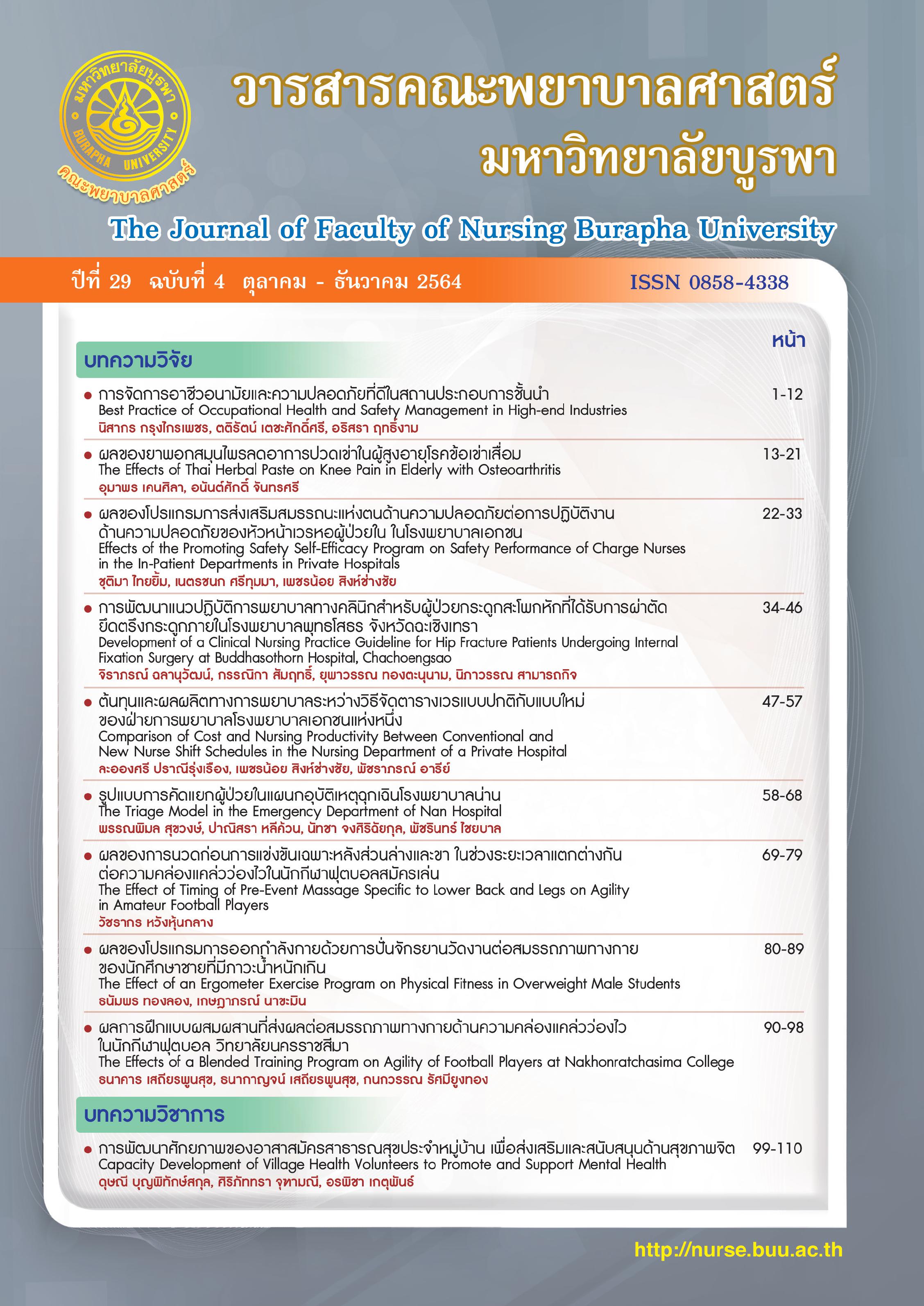Development of a Clinical Nursing Practice Guideline for Hip Fracture Patients Undergoing Internal Fixation Surgery at Buddhasothorn Hospital, Chachoengsao
Keywords:
Hip fracture, open reduction internal fixation, clinical nursing practice guidelinesAbstract
This research aimed to study the situations regarding the care of hip fracture patients, to develop a clinical nursing practice guideline for patients undergoing open reduction internal fixation, and to study the effectiveness of implementing the clinical nursing practice guidelines. The sample for this study consisted of male and female hip fracture patients undergoing open reduction internal fixation at the orthopedic ward of Chachoengsao Hospital. The study took place between April and September 2021. The sample was 60 patients who met inclusion criteria, divided equally into 30 control and experimental groups. The data collection tools were the readiness to discharge from hospital questionnaire, the rehabilitation behavior questionnaire, the illness and treatment history record form of the patients, and the questionnaire on the use of clinical nursing practice guidelines. Data were analyzed by descriptive statistics, Independent t-test and ODD Ratio.
The results showed that patients who received care following the clinical nursing practice guidelines had higher perceived readiness to discharge from hospital (p < .001), higher rehabilitation behavior (p < .001), and lower length of stay (p < .05) compared to those who received usual care. Patients who received conventional care were 4.33 times more likely to have complications. (OR = 4.33; 95% CI = 1.04 - 1.99). The results of this study could be applied to the care for hip fracture patients to enhance recovery and speed return to their normal lives.
References
Córcoles-Jiménez, M. P., Villada-Munera, A., Del Egido-Fernández, M. Á., Candel-Parra, E., Moreno-Moreno, M., Jiménez-Sánchez, M. D., & Piña-Martínez, A. (2015). Recovery of activities of daily living among older people one year after hip fracture. Clinical Nursing Research, 24(6), 604 -623.
Ferguson, M., Brand, C., Lowe, A., Gabbe, B., Dowrick, A., Hart, M., & Richardson, M. (2008). Outcome of isolate tibial shaft fractures treated at level 1 trauma centres. InjuryInternational Journal of the Care of the Injured, 39(2), 187-195.
Gabel, C. P., Osborne, J., & Burkett, B. (2015). The influence of ‘Slacklining’on quadriceps rehabilitation, activation and intensity. Journal of Science and Medicine in Sport, 18(1), 62-66.
Hadeed, M. M., Kandil, A., Patel, V., Morrison, A., Novicoff, W. M., & Yarboro, S. R. (2017). Factors associated with patient-initiated telephone calls after orthopaedic trauma surgery. Journal of Orthopedic Trauma, 31(3), e96-e100.
Janyarat, G., Sathitwittayanan, S., & Sattayawiwat, W. (2016). The quality indicators of nursing outcomes for patients with hip fracture undergoing hip arthroplasty. Journal of Safety and Health, 31(4), 45-56. (in Thai)
Khosrojerdi, H., Tajabadi, A., Amadani, M., Akrami, R., & Tadayonfar, M. (2018). The effect of isometric exercise on pain severity and muscle strength of patients with lower limb fractures: A randomized clinical trial study. Medical Surgical Nursing Journal, 7(1), e68104. doi: 10.5812/msnj.68104. (in Thai)
Pimentel, L. (2006). Orthopedic trauma: Office management of major joint injury. Medical Clinics, 90(2), 355-382.
Pradeep, A. R., KiranKumar, A., Dheenadhayalan, J., & Rajasekaran, S. (2018). Intraoperative wall fractures during dynamic hip screw fixation for intertrochanteric fractures-incidence, causative factors and clinical outcome. Injury, 49(2), 334-338.
Phelps, E. E., Tutton, E., Griffin, X., & Baird, J. (2019). A qualitative study of patients’ experience of recovery after a distal femoral fracture. Injury, 50(10), 1750-1755.
Purivatanakul N., Tipmongkol V., & Wongleang K. (2007). Effects of a telephone education program on self-care behavior for rehabilitative fractured femur patients.Songklanagarind Medical Journal, 25(1), 19-27. (in Thai)
Rodsub, L., & Suwinthakorn, O. (2014). Development of nursing practice guideline for hip fracture elderly patients undergoing hip replacement surgery. Journal of Nursing, Ministry of Public Health, 21(1), 35-48. (in Thai)
Salpakoski, A., Törmäkangas, T., Edgren, J., Sihvonen, S., Pekkonen, M., Heinonen, A., & Sipilä, S. (2014). Walking recovery after a hip fracture: a prospective follow-up study among community-dwelling over 60-year old men and women. BioMed Research International, 2014, 1-11. doi:10.115572014/289549
Sriprasong, S. (2008). Empirical test model of daily functioning in patients with acute myocardial infarction after hospital discharge. Doctoral Dissertation, Nursing, Graduate school, Mahidol University.(in Thai)
Srisaard, B. (2015). Preliminary research (9th ed.) Bangkok: Suriyasan. (in Thai) Statistics Department. (2020). Medical Informatics. Chachoengsao: Buddhasothorn Hospital. (in Thai)
Thongchai, C. (2005). Development of clinical practice guidelines. Journal of the Council of Nursing, 20(2), 63-76. (in Thai)
Wirotyut, S., Kengkanpanich, M., Kengkanpanich, T., & Tansakul, S. (2014). Effectiveness of post surgery rehabilitation program for elderly patients with hip fracture in Phramongkutklao Hospital. Journal of the Royal Thai Army Nurses, 15(2), 187-194. (in Thai)





